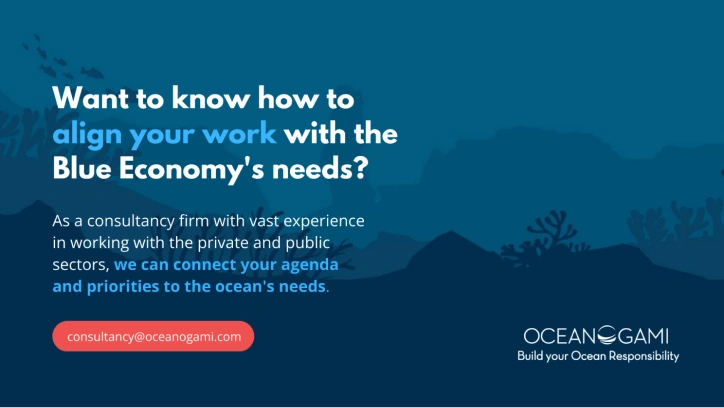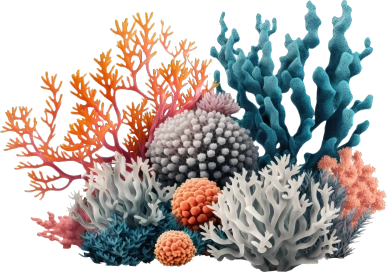In the Mediterranean, there’s an underwater treasure known as Posidonia oceanica, forming meadows crucial for our oceans’ well-being. But what exactly is it, and why should we care about this marine plant? Well, get ready because we will dive into this fascinating world of Posidonia oceanic.
Posidonia oceanica isn’t an algae, contrary to what many believe, but a unique plant that plays a vital role in the Mediterranean Sea.
Its roots keep sediment in place, creating crucial zones for oxygen production and serving as homes for various marine species.
What is Posidonia Oceanica?
This special seagrass is exclusive to the Mediterranean, growing in groups underwater, usually up to 40-45 meters deep. It thrives in saltwater with temperatures between 10 to 28 degrees Celsius and needs sunlight for photosynthesis. It doesn’t like areas with less salt, so you won’t find it near the mouths of rivers.
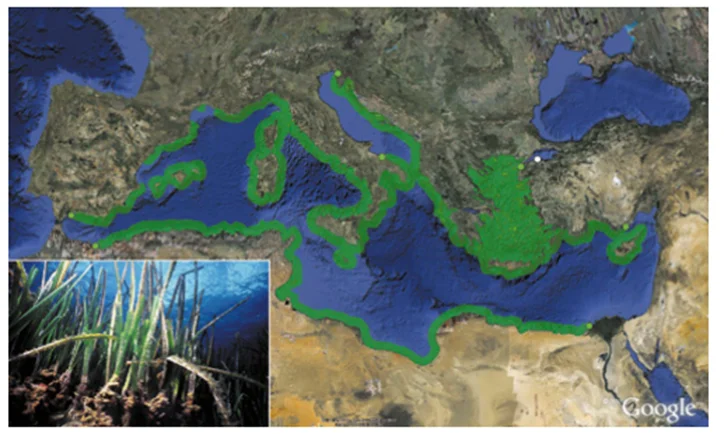
Just like plants on land, Posidonia oceanica being a marine plant, has roots, stems, leaves, flowers, and fruits. Interestingly, the leaves grow all year round and have a lifespan of 5 to 8 months, with some enduring up to an impressive 13 months, providing essential habitats for marine life.
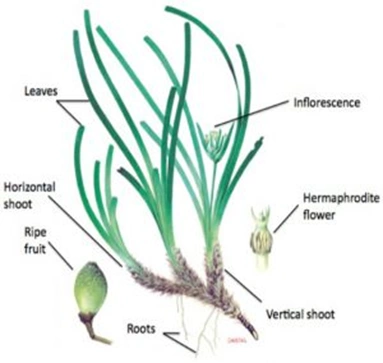
In its life journey, Posidonia oceanica takes its time to grow, using both asexual and sexual methods to reproduce. As spring arrives and the water warms up, the leaves grow faster, and you might see the first fruits and seeds. By autumn, Posidonia drops its dry leaves along with tiny hitchhiking organisms. These bits wash ashore, bringing sediment and nutrients, creating a shield for the upcoming winter. During this time, fresh, green leaves sprout, and the plant blooms again.
Why should we care?
In the Mediterranean, there are many ecosystem services provided by Posidonia oceanica, and these are some of the reasons that will make you want to protect it. The ecosystem services are the benefits we get from nature, It’s like the “good things” that the environment does for us, such as:
- Lungs of the sea: Posidonia meadows contribute significantly to water oxygenation by producing oxygen through photosynthesis. According to a study by the Mediterranean Institute for Advanced Research (IMEDEA) and the BBVA Foundation, the Mediterranean Posidonia population generates an impressive 14 to 20 liters of oxygen per square meter every day.
- Home sweet home for marine life: The meadow acts as shelter, breeding and feeding habitat for a quarter of the species (flora and fauna) living in the Mediterranean.
- Plant matter production: Posidonia meadows produce large amounts of plant matter, feeding a diverse marine fauna. They’re estimated to be worth more than $19,000 USD per hectare annually, making them incredibly valuable ecosystems.
- Water quality indicator: Posidonia is considered an indicator species for the overall quality of coastal waters, as it can only grow in clean, unpolluted waters. Therefore, it is an effective tool for monitoring the general quality of coastal water and coastal environments.
- Carbon sink: Posidonia meadows are crucial for capturing and storing CO2 from the atmosphere, acting as a significant carbon sink. This process, known as blue carbon, aids in reducing greenhouse gasses and contributes to climate regulation on our planet.
- Protects the beach against erosion: the leaves reduce water velocity, settling sediment on the seabed. Before reaching the deep seabed, dead Posidonia leaves often pile up on beaches, forming wedge-shaped structures commonly known as “beach benches”. These benches protect beaches from erosion, creating unique environments for various species.
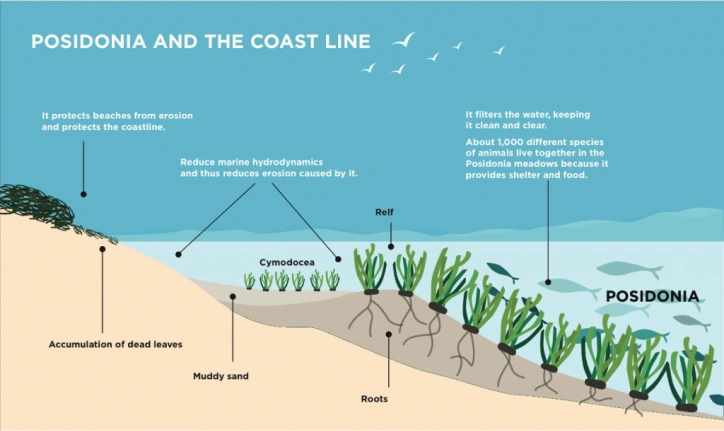
Benefits of Posidonia on beaches and the coastline. Illustration by Sant Josep.
Challenges
Over the years, coastal urbanization and industrialization have led to the disappearance or alteration of many Posidonia meadows.
Unfortunately, these vital seagrass habitats are facing alarming decline due to climate change and direct human activities near coasts, such as coastal development, fishing, aquaculture, and anchoring, posing threats like habitat fragmentation and overgrazing by sea urchins or herbivorous fish.
Restoring Destroyed Ocean Meadows – A Call to Action
It’s crucial to note that Posidonia Oceanica is safeguarded by European policies, and both the species and its habitat enjoy specific legal protection in various European countries.
To ensure the preservation and restoration of Posidonia Oceanica meadows, several projects have been initiated, involving methods like transplanting using cuttings or seeds.
Numerous noteworthy projects have been undertaken along the Mediterranean shores, focusing on the protection and conservation of this vital marine habitat.
Some noteworthy examples include:
- MedKeyHabitats (2013-2016): The goal is to map key marine habitats such as Posidonia seagrass and promote their conservation in Mediterranean countries through the establishment of Specially Protected Areas of Mediterranean Importance (SPAMI).
- ANÈL·LIDES SERVEIS AMBIENTALS MARINS: Their citizen science project called Posidonia Activa takes place on the seabed near the Catalan Coast. Its main objective is to map the seabed in areas that are not protected to find and precisely define seagrass meadows of marine plants called phanerogams, which are those that produce flowers and seeds. They are also studying the variety of life associated with these meadows which helps to identify the most important areas for marine life and prompts further action to protect these ecosystems that are unique to the Mediterranean and in danger of declining.
- MEDSEAGRASS (2016-2022): This is a project that the Fundación MEDSEA began in partnership with the Protected Marine Area of the Sinis Peninsula—Mal di Ventre Islanda, funded by the MAVA Foundation. The goal of the project is to restore Posidonia in an area of 300 m2, using an app to cancel the impact of the moorings in the area.
- Posidonia Gardeners (2023): Combines the professional and citizen scientists’ collaboration, and education to create a positive and lasting impact on the Mediterranean’s largest islands (Sicily, the Aeolian Islands, and Malta). The goal is united to collect data and actively participate in the process of seagrass replantation.
- Archipelagos Institute of Marine Conservation (2023): Innovative Restoration: Blooming Success in Posidonia Oceanica Seagrass Planting Project in the Southeastern Aegean Sea. A significant milestone was achieved as Posidonia flowering was observed after a decade, marking the success of the initiative. Collecting over 12,000 seeds, the researchers meticulously prepared and executed the planting process, demonstrating the dedication of the Archipelagos Institute. Despite the slow natural growth rate of Posidonia seagrass, approximately 6 cm/year, the institute remains committed to implementing solutions to combat growing threats to marine life.” Image below shows the seeding of Posidonia oceanica in the “Posidonia Oceanica Planting Project” in the southeastern Aegean Sea.
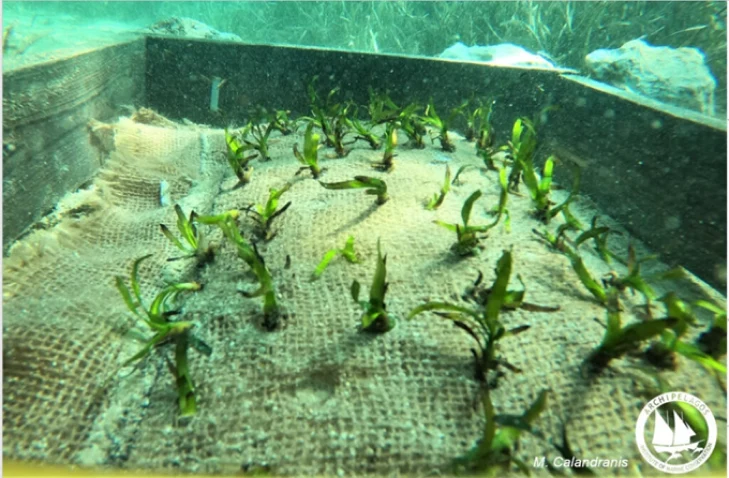
Planting of an underwater posidonia garden by researchers from the Archipelagos Marine Conservation Institute.
Conclusion
Posidonia oceanica isn’t just a sea plant – it’s like the backbone of the Mediterranean Sea. It’s way more important than just its green leaves underwater. Think of it as the lungs for a whole bunch of sea creatures, a cozy home for amazing marine animals, and a superhero against the sea eating up the land.
Its importance lies not only in its role as a carbon reservoir or CO2 offset but also in its contribution to restoring and protecting marine biodiversity.
As an organization, by safeguarding and restoring this species, you can not only preserve its ecological function but also aid in the protection and restoration of marine biodiversity.
So, if your company has the chance to help with Posidonia oceanica restoration projects or support its research, go for it! At an individual level, you can also do your part from home by becoming an Eco-educator and sharing this information with your friends and family.
At Oceanogami, we think education is the key to taking care of our oceans, and your help can really make a big difference.
